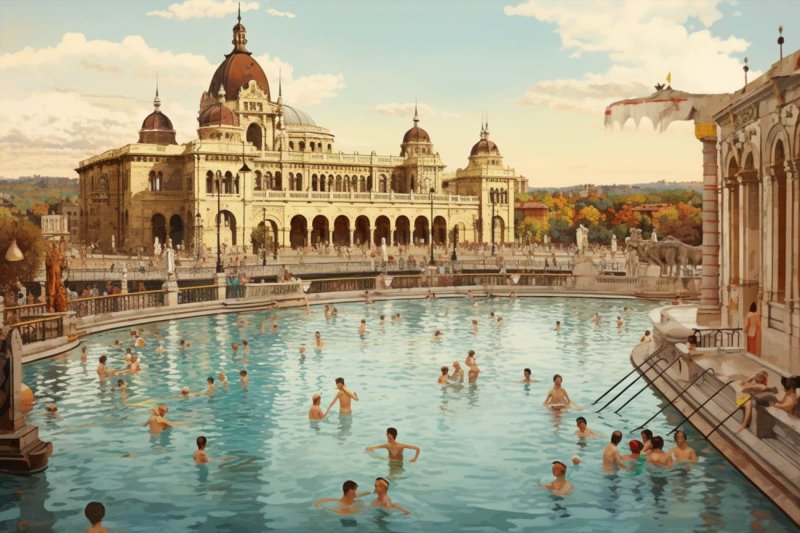Culture of thermal baths in Budapest
The Culture of Thermal Baths in Budapest
Budapest, often referred to as the "City of Spas," is renowned for its rich culture and history of thermal baths. These thermal baths are not only a unique attraction but also an integral part of the city's identity and lifestyle. The combination of stunning architecture, therapeutic mineral-rich waters, and the social tradition of bathing has created an unparalleled experience for both locals and tourists.
Historical Significance and Architecture
The culture of thermal baths in Budapest dates back to Roman times, when the region was known as Aquincum. The Romans were among the first to recognize the healing properties of the thermal springs that are abundant in the area. However, it was during the Ottoman rule in the 16th century that the city's bath culture truly flourished. Several of the city's most iconic thermal baths, such as the Rudas and Király Baths, bear distinct Ottoman architectural influences.
The architecture of these thermal baths is a captivating blend of various styles, including Gothic, Renaissance, and Art Nouveau. The Gellért Baths, for instance, boast stunning Art Nouveau design elements that transport visitors to a different era. The intricate mosaics, ornate columns, and grand halls contribute to the unique charm of each bathhouse.
Therapeutic and Relaxation Benefits
Beyond their aesthetic appeal, the thermal baths offer numerous health benefits. The mineral content of the thermal waters is believed to have healing properties for various ailments, such as joint pain, muscle tension, and skin conditions. The warm temperatures and mineral composition create a relaxing and rejuvenating experience that draws visitors seeking both physical and mental wellness.
Each thermal bath in Budapest offers a slightly different mineral composition, catering to specific health concerns. For instance, the Széchenyi Baths are known for their high calcium and magnesium content, making them particularly beneficial for bone and muscle health. On the other hand, the Gellért Baths' water is rich in sulfur, which is believed to have positive effects on the respiratory system.
Social and Cultural Tradition
Bathing in Budapest is more than just a health regimen; it's a social and cultural activity deeply embedded in the city's way of life. Locals and visitors alike gather at these baths not only for their therapeutic properties but also for socializing and relaxation. The thermal baths have become meeting places for friends and families to unwind, converse, and enjoy the healing waters together.
The "chess culture" at the Széchenyi Baths is a unique aspect of Budapest's thermal bath tradition. Visitors can often observe intense chess matches taking place amidst the soothing waters, combining leisure and intellectual engagement.

Budapest: Lukács Thermal Bath Full-Day Spa Ticket
Experience the luxurious healing and relaxation of the Lukács Thermal Bath in Budapest. Named after its founder Dr. Miklos Lukacz, who discovered the therapeutic benefits of the thermal waters in the late 1800s, this historic spa provides you with traditional treatments and pampering for centuries.
Indulge in a full day of luxurious healing and relaxation in a historic building. Relax in the thermal waters and let the healing power of the minerals soothe you. Choose from a range of saunas and steam rooms, each with its unique atmosphere and benefits. Swim in the outdoor pools heated to a comfortable temperature and featuring a series of jets and waterfalls.
Enjoy the thermal waters, rich in minerals like calcium, magnesium, and sulfur – known for their therapeutic properties. Indulge in traditional Hungarian treatments while you enjoy the grandeur of the historic building. Treat yourself to a relaxing massage, or enjoy the therapeutic effects of the thermal pool.
Highlights:
- Indulge in a full day of luxurious healing and relaxation in a historic building
- Relax in the thermal waters and let the healing power of the minerals soothe you
- Choose from a range of saunas and steam rooms, each with a unique atmosphere
- Swim in heated outdoor pools equipped with a series of jets and waterfalls
- Experience the pampering of the historic spa and create a memorable visit
Includes: Full-Day entrance ticket, The use of a cabin or locker
Not suitable for: Children under 14 years, Pregnant women
Meeting point: Please present your voucher at the entrance.
Important information:
- What to bring: Swimwear, Towel, Flip-flops, Swimming cap
- Swimwear covering the whole body is not permitted
Check availability and reserve now & pay later to book your spot and pay nothing today.
You might also like:
- ENTRY TICKET Budapest: Széchenyi Spa Full Day with Optional Pálinka Tour
- ENTRY TICKET Budapest: Full-Day Gellért Spa Ticket
- ENTRY TICKET Budapest: Margaret Island Day Spa Entry Ticket
- ENTRY TICKET Budapest: Rudas Spa Wellness and Dining Experience
Customer reviews: Overall rating 3.6/5 based on 10 reviews
Filter: All traveler types - Couples, Group of friends, Solo travelers, Families
By star rating: 5 stars, 4 stars, 3 stars, 2 stars, 1 star
Sort by: Recommended
July 17, 2023 - GetYourGuide traveler from France - Verified booking - Helpful?/
July 13, 2023 - GetYourGuide traveler from Germany - Verified booking - Helpful?/
June 8, 2023 - GetYourGuide traveler from Spain - Verified booking - Helpful?/
Interesting Facts about Thermal Baths in Budapest
Budapest, the capital of Hungary, is renowned for its exquisite thermal baths that offer relaxation, rejuvenation, and a unique cultural experience. The city's thermal baths have a rich history dating back centuries, and they continue to attract visitors from around the world. Let's explore some fascinating facts about these iconic Budapest thermal baths.
1. Historical Significance
The thermal baths in Budapest have a history that can be traced back to Roman times. The Romans were among the first to recognize the healing properties of the thermal springs found in the region. Over the centuries, various civilizations and cultures have contributed to the development of these baths, resulting in the magnificent structures we see today.
2. Architecture and Design
The thermal baths in Budapest are not just about relaxation; they are also architectural marvels. One of the most famous baths, the Széchenyi Thermal Bath, boasts stunning Neo-Baroque architecture. The Gellért Thermal Bath, on the other hand, features Art Nouveau design elements that transport visitors to a bygone era.
3. Medicinal Benefits
The mineral-rich thermal waters of Budapest are believed to have numerous health benefits. The water contains minerals like calcium, magnesium, and sulfates, which are thought to alleviate various ailments such as arthritis, joint pain, and skin conditions. Many visitors come to these baths not only for leisure but also for the potential therapeutic effects.
4. Social and Cultural Hub
Thermal baths in Budapest have always been more than just places for bathing. They serve as important social and cultural gathering spots for locals. These baths provide a space for people to meet, relax, and engage in meaningful conversations, contributing to the city's vibrant social fabric.
5. The Tradition of Bath Parties
Budapest takes its thermal baths to another level by hosting unique bath parties. These lively events, known as "sparties," combine music, dance, and the enchanting ambiance of the baths. Visitors can enjoy a vibrant nightlife experience while soaking in the warm, mineral-rich waters.
Interesting Facts about Thermal Baths in Budapest
Budapest, the capital city of Hungary, is renowned for its rich history, stunning architecture, and most notably, its thermal baths. These baths have been a significant part of the city's culture for centuries, offering both relaxation and therapeutic benefits to locals and tourists alike.
The thermal baths in Budapest are not just places to unwind; they also hold a unique place in the city's history. Many of these baths date back to the Roman times when the region was known as "Aquincum." The Romans were among the first to recognize the healing properties of the thermal springs found in the area, and their legacy still lives on in the various bathhouses scattered throughout the city.
One of the most famous thermal baths in Budapest is the Szechenyi Thermal Bath. It's not only the largest medicinal bath in Europe but also one of the most picturesque. The bath complex features an array of indoor and outdoor pools, each filled with water rich in minerals that are believed to have numerous health benefits.
Another iconic bathhouse is the Gellert Thermal Bath, known for its stunning Art Nouveau architecture. The intricate mosaic tiles, grand columns, and sculptures make this bathhouse a feast for the eyes. The Gellert Thermal Bath is also home to a variety of spa treatments, ensuring a holistic relaxation experience.
One might wonder about the source of the thermal waters in Budapest. These waters emerge from deep underground, enriched with minerals like calcium, magnesium, and sulfur. The temperature of the water can vary from bath to bath, with some offering warm, soothing pools and others providing hotter pools suitable for those seeking more intense therapeutic effects.
The tradition of thermal bathing in Budapest has not waned over the centuries. It remains an integral part of local life, offering a way to unwind, socialize, and even heal. The baths are not just frequented by tourists looking for a unique experience; they are also beloved by locals who appreciate the tradition and the positive impact of the thermal waters on their well-being.
If you're planning a visit to Budapest and its thermal baths, it's essential to know the etiquette. Most baths require visitors to shower before entering the pools, and it's customary to wear swimwear. Some baths even offer rental services for swimwear and towels, so you don't need to worry if you didn't pack your own.
Overall, Budapest's thermal baths offer an unforgettable experience that combines history, relaxation, and rejuvenation. Whether you're soaking in the warm waters of Szechenyi or enjoying the stunning architecture of Gellert, these baths are a testament to the city's unique culture and its appreciation for the therapeutic powers of its natural springs.
Historical Baths and their Cultural Significance in Budapest
When it comes to the fusion of relaxation, culture, and history, Budapest's historical baths stand as remarkable landmarks that embody the city's rich past and diverse cultural influences. The thermal baths, or "fürdő" in Hungarian, have been an integral part of Budapest's identity for centuries, offering not only therapeutic benefits but also a glimpse into the city's historical tapestry.
The tradition of thermal baths in Budapest can be traced back to the Roman era when the city was known as Aquincum. The Romans were among the first to recognize and utilize the healing properties of the natural thermal springs that abound in the region. Over time, as the city evolved and changed hands through various rulers, the bathing culture continued to thrive.
One of the most iconic and oldest baths in Budapest is the Gellért Baths, which dates back to the Turkish occupation of Hungary. The Ottoman Turks greatly valued thermal baths, and they left an indelible mark on Budapest's bath culture. The Turkish-style architecture and design of the Gellért Baths are a testament to this influence.
However, the pinnacle of Budapest's thermal bath culture emerged during the 19th century, a period of intense urban development and renewal. The Széchenyi Thermal Bath, built in neo-baroque style, is a prime example of this era. Its grandeur and opulence attracted visitors from all walks of life, turning the bathhouses into social hubs where people gathered not only for healing but also for socializing and leisure.
The historical baths of Budapest are not just about architecture and relaxation; they are a reflection of the city's social fabric and its people. Locals and tourists alike gather in these baths, transcending generations and backgrounds. The experience of soaking in the thermal waters while surrounded by stunning architecture fosters a unique sense of unity and cultural appreciation.
Cultural Significance
The historical baths of Budapest hold immense cultural significance. They serve as living monuments that narrate the city's evolution, from its Roman beginnings to the Turkish influence and the prosperous 19th-century period. These baths also showcase the art and architecture of different eras, making them essential destinations for enthusiasts of history and culture.
Beyond their architectural beauty, the baths encapsulate the concept of wellness and relaxation as a communal experience. The practice of bathing is deeply ingrained in Hungarian culture, and the baths provide a space for people to unwind, connect, and rejuvenate. The egalitarian nature of the baths ensures that individuals from all walks of life can enjoy their healing benefits.
Moreover, the historical baths have transcended their original functions and have become platforms for cultural events, performances, and exhibitions. This dynamic infusion of tradition and modernity further cements their relevance in contemporary society.






